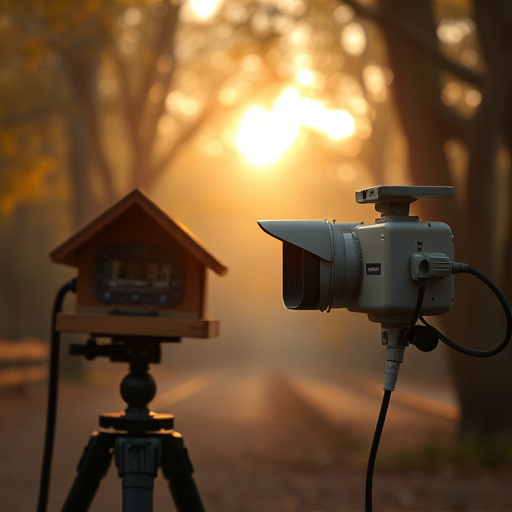Uncover the art of wireless surveillance with our comprehensive guide on location detection tips. From understanding the intricacies of tiny cameras for home monitoring to choosing the perfect spot for optimal signal, we’ve got you covered. Learn how to discreetly place your cameras without compromising visibility and explore environmental factors crucial for clear footage. Discover advanced techniques to accurately detect locations and stay ahead in home monitoring.
- Understanding Wireless Surveillance Equipment: A Brief Overview
- Choosing the Right Location for Optimal Signal Strength
- Discreet Placement: How to Hide Your Cameras Effortlessly
- Environmental Considerations for Clear Footage
- Advanced Techniques for Accurate Location Detection
Understanding Wireless Surveillance Equipment: A Brief Overview
Wireless surveillance equipment, especially tiny cameras designed for home monitoring, have transformed how we secure our living spaces. These discreet devices offer a range of benefits—from remote access to live footage to motion detection capabilities—all accessible through a simple smartphone connection. Understanding their functionality is key to maximizing their potential as effective security tools.
Tiny cameras are often equipped with advanced sensors and AI-powered features that enable them to capture high-resolution images and videos, even in low-light conditions. Many models can be easily hidden within everyday objects, making them ideal for unobtrusive home monitoring. By integrating these devices into your home security system, you gain a powerful tool for deterring intruders and ensuring the safety of your loved ones.
Choosing the Right Location for Optimal Signal Strength
When setting up wireless surveillance equipment, one crucial factor is selecting the ideal location for maximum signal strength. Since tiny cameras for home monitoring often rely on wireless connections, ensuring a strong and stable signal is essential for efficient recording and live streaming. The best spots are typically areas with direct line-of-sight to the camera, free from physical obstructions like walls or trees that could interfere with the signal.
For optimal results, place your surveillance devices in elevated positions, such as high shelves or rooftops, to minimize signal blocking. Keep them away from large metallic objects that can absorb or reflect signals. Additionally, consider proximity to a Wi-Fi router for better connectivity and smoother video transmission, especially for real-time monitoring applications.
Discreet Placement: How to Hide Your Cameras Effortlessly
When setting up wireless surveillance equipment, discreet placement is key to maintaining an unobtrusive and effective security system. One of the biggest advantages of tiny cameras for home monitoring is their ability to blend into the environment. Mounting them in hidden locations like corner shelves, door frames, or even behind artwork can make them nearly invisible to potential intruders.
Using small, compact camera models allows for creative placement options without compromising on quality. These miniature devices offer advanced features and clear footage, ensuring your home is thoroughly monitored while maintaining an aesthetically pleasing atmosphere. By thinking outside the box and taking advantage of these hidden spots, you can create a comprehensive security network that is both subtle and powerful.
Environmental Considerations for Clear Footage
When setting up wireless surveillance equipment, especially tiny cameras for home monitoring, environmental factors play a significant role in ensuring clear and reliable footage. The placement of the camera should account for natural obstructions like trees, bushes, or architectural elements that might block the line of sight. Opting for higher placement points can often overcome these obstacles and provide broader coverage.
Additionally, lighting conditions are critical; cameras perform best under well-lit environments. Positioning them near windows or in areas with good artificial lighting can significantly enhance video quality. Avoiding direct sunlight, which may cause excessive glare, is also advisable. Environmental considerations, therefore, are key to achieving optimal results from your tiny cameras for home monitoring system.
Advanced Techniques for Accurate Location Detection
In the realm of wireless surveillance, accurate location detection has evolved beyond traditional methods. Today, tiny cameras designed for home monitoring play a pivotal role in enhancing security with advanced techniques. These miniature devices, often disguised as everyday objects, employ a combination of GPS tracking, Wi-Fi triangulation, and motion sensors to pinpoint exact locations within a property.
By integrating these technologies, users can remotely monitor activities, receive real-time alerts for intrusions, and ensure the safety of their homes or businesses. Moreover, advanced algorithms analyze video feeds, enabling more precise location detection even in complex indoor environments where traditional signals might be hindered. This level of precision allows for better decision-making and proactive security measures using tiny cameras for comprehensive home monitoring.
Wireless surveillance equipment, especially tiny cameras for home monitoring, offers unparalleled convenience and peace of mind. By understanding the technology, choosing optimal locations, ensuring discreet placement, and considering environmental factors, you can maximize signal strength and capture clear footage. Advanced techniques for accurate location detection further enhance the capabilities of these powerful tools, making them an effective solution for home security.
